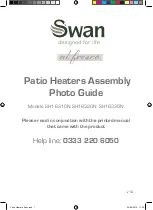
INSTRUCTIONS FOR
INSTALLATION
In the event of peculiarities or unclear situations
regarding safe work, consult the safety engineer
or any other authorized person in charge of safe-
ty at work.
If the packaging of the floor converter is dam-
aged, consult the manufacturer before installa-
tion.
Place the floor convector to prepared flat sur-
face.
The distance between convector and wall can be
as low as possible, however, it should not exceed
300 mm. Condensation elimination on cold sur-
faces efficiency decreases with the distance
between convector and wall. Convector should
be installed in such way, that air discharge
should be oriented into the room (TKH conve-
ctor), or into the window (other convector types).
In the event of uneven surfaces, levelling screws
❸
on the bottom of the convector, part of the
standard equipment, have to be used to adjust
the height. In case of false floor installation,
accessory 029 is available (levelingmand sup-
port legs).
❹❺
Legs are mounted in special
holders, in pop nut M10. The optimal convector
height is achieved by regulating the leg with a
screw and finally fixing it with a spanner size 15.
❻
Legs can be regulated from 10 mm do 100
mm height.
❼
When the optimal convector posi-
tion is achieved, it needs to be fixed with a screw
through a fixing profile into the floor. When the
convector is adjusted to the correct position and
lined to desired height, fix it with the screw. In-
stallation of thermal and noise insulation layer is
recommended between the convector and con-
crete. Convector can be supplied with housing
thermal insulation (accessory 017 - elastalon s =
5 mm). When the housing of the floor convector
is placed directly to the concrete surface, make
sure that contact is distributed along complete
surface of the convector, otherwise increased
noise level can apply (forced convection only). In
order to prevent the grille from deformation and
dirt, remove it before the installation and place
protection cover (accessory 018) to its place.
❽
If you do not order the 018 accessory, spacers
have to be inserted on the upper part of the
housing
❾
, where the grille is later placed, which
prevent the housing from deforming and which
are supplied together with the converter. The
cover and spacers must suit the size of the con-
vector’s housing and can only be removed after
the convector is ready for operation.
If required (TKH), the drain for condensation
should run through the Φ16 mm connection on
the bottom side of the collection tray, inside of
the convector’s housing. The pipe (connection)
can lead from the convector from the transversal
or longitudinal side and then through the siphon
into the drain. Before operation, pour water into
the condensation collection tray. Make sure the
water is flowing through the pipe intended for
draining the condensation. The collection tray
must be clean.
Control accessories on the water side (01, 02,
03, 04) are attached to the convector upon
delivery and are not installed to the heat
exchanger. When connecting straight valves and
shut-off cocks, nut should be counter-tightened
❿
. When tightening angle valves and shut-off
cocks, counter-torque should be applied with
threaded rod (1/2” thread)
⓫
. If not, attached
unit can be removed from the heat exchanger,
causing damage on the installation joint. It can
cause water leakage in the joint. Standard valves
and closing devices have an inside thread for
connecting them to the heating or cooling
system. It is also recommended to check the
leakproofness of the installation before operati-
on.
Recommendation: the pipe connection between
the valves on the heat conductor and the pipe
distribution element should be flexible under the
conductor in order to enable easier cleaning.
Before pouring concrete, it is required to fill all
the holes in the housing of the floor convector by
adding insulation around the convector to pre-
vent the concrete entering the inside of the floor
convector. The thickness of the insulation should
depend on the room and the pressure around
the convector. Insulation also prevents the heat-
ing and drying of the finishing layer of floor
(parquet etc.).
When applying concrete to the space around the
convector, consider height difference for the final
layer (carpet, laminate floor, ...).
Remove the cover and spacers and put the grille
on the housing .
The air flow through the converter depends on
the convector’s rotations per minute; these are
controlled with a room thermostat with a three-
level or continuous speed switch. The thermostat
must be fitted exposed in the room where the
floor convector has been installed at the same
height as other switches (approx. 1.5 m above
the floor where there is no impact from the sun
or other heating or cooling devices). The connec-
tor is connected to the thermostat according to
4
























